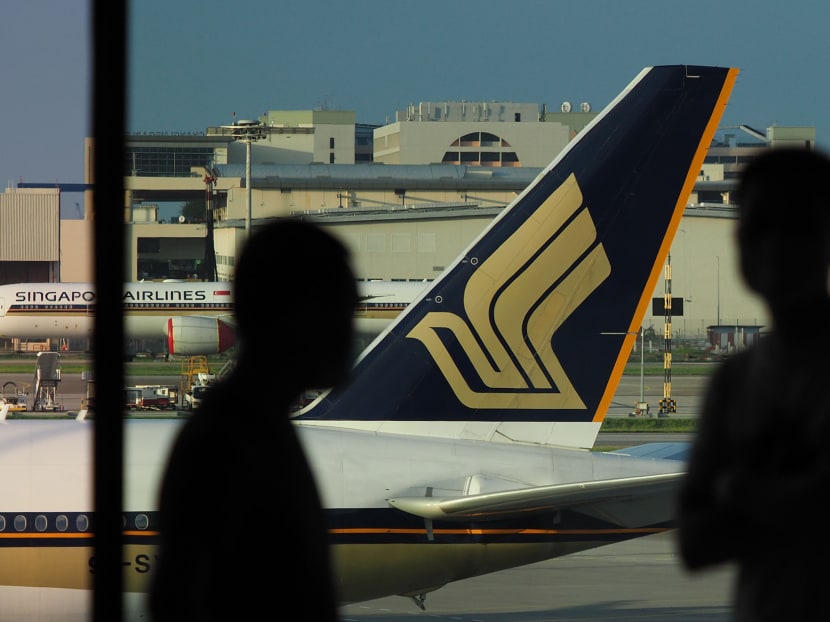Govt doing its utmost to support Singapore Airlines, Changi Airport Group through ‘deep crisis’: Ong Ye Kung
SINGAPORE — Once a bustling hub, Changi Airport was the seventh busiest airport in the world before the Covid-19 pandemic ravaged air travel. Today, it has dropped to 58th place.

The two icons of Singapore’s aviation sector — Changi Airport Group and Singapore Airlines — have not been spared the economic ravages of Covid-19.
- Minister Ong Ye Kung has pledged to support Singapore Airlines, Changi Airport Group and other aviation firms “as much as we can”
- SIA would not exist today were it not for its recent recapitalisation exercise, Mr Ong said
- CAG has also lost its revenue streams owing to lower passenger volume, fewer flights
SINGAPORE — Once a bustling hub, Changi Airport was the seventh busiest airport in the world before the Covid-19 pandemic ravaged air travel. Today, it has dropped to 58th place.
And were it not for its recent recapitalisation exercise, national carrier Singapore Airlines (SIA) would not exist today, Transport Minister Ong Ye Kung said on Tuesday (Oct 6) in a ministerial statement in Parliament on the recovery of the aviation sector.
Even with the measures taken, the airline is still “far from being out of the woods”, Mr Ong said, as he pledged to revive Singapore’s air hub as a top national priority and do “as much as we can” to support SIA, the airport and other aviation businesses.
Covid-19 has cut a deadly economic swathe across the globe, bringing air travel to a near-standstill, even though borders are slowly reopening in parts of the world.
The two icons of Singapore’s aviation sector — Changi Airport Group (CAG) and SIA — have not been spared.
They are facing a deep crisis, said Mr Ong.
There are now direct flights from Singapore to just 49 cities, compared with 160 before the pandemic.
At present, Changi Airport Terminal 1 is also seeing fewer passengers than when it opened in 1981, said Mr Ong.
Changi Airport is serving just 1.5 per cent of its usual passenger volume and 6 per cent of its typical number of passenger flights.
If cargo flights are added to the mix, Changi Airport fares slightly better — at 17 per cent of its total flight volumes.
Mr Ong said that cargo flights are operating at more than two and half times their regular frequency, which has partially offset the reduction in passenger flights.
Six Members of Parliament (MPs) filed questions relating to the aviation sector over the last two days of parliamentary sittings. Among other things, they asked about Singapore’s plans to open its borders further, revive the aviation industry and promote safe air travel through the country.
CAG’S REVENUE LOSSES
As a result of lower passenger volumes and fewer flights, CAG has lost its revenue streams, Mr Ong said.
The amount of service charges it is collecting from airlines and passengers is now miniscule.
Shops and restaurants at the airport are also serving far fewer customers, and many stores have shut. CAG is also dipping into its reserves, and preserving cash and retaining core capabilities, said Mr Ong.
Mr Gerald Giam, Workers’ Party MP for Aljunied Group Representation Constituency (GRC), asked Mr Ong why Changi Airport had slipped from being the seventh busiest airport to 58th spot.
Mr Ong said that it was because Singapore is small, relies entirely on international travel and does not have a domestic market.
“If you are a big country, China or the United States, you have a much bigger population who is flying out, and not just flying within the country, and that generates international traffic, which is why there is a certain cushion,” he said.
Bukit Panjang MP Liang Eng Hwa noted that quite a number of airlines have moved out of Singapore to other hubs or found cheaper places for their operations.
He wondered if Singapore was confident about attracting major airlines to choose it as a hub again after air travel resumes.
In response, Mr Ong said he recently met a senior executive of a regional airline who told him to “please open up aviation again because our airlines want to come back to Singapore”.
“So I think we are still top of mind (for) many of the airlines, but we have to start taking steps to open up our borders,” he said.
Mr Ong reiterated that the Government would continue doing its utmost to support the aviation sector.
Among the slew of measures to prop up the sector is the Jobs Support Scheme, which provides employers with wage support to help them retain Singapore employees. The hard-hit aviation sector benefits from the highest tier of support.
The Government has also provided cost relief through the Enhanced Aviation Support Package, under which an extra S$187 million will be injected into the ailing industry.
The package, originally totalling S$350 million, was announced in March to fund measures such as rebates on aircraft landing and parking charges, and rental relief for airlines, ground handlers and cargo agents.
“But the most meaningful support we can give to our aviation companies is to restore passenger traffic and revive our air hub, in a controlled and safe manner,” said Mr Ong.
SIA'S PLIGHT
To shore up its balance sheet, SIA in March aimed to raise around S$15 billion by issuing shares to existing shareholders and mandatory convertible bonds, with state investor Temasek Holdings pledging to mop up any remaining unsubscribed shares and bonds.
So far, it has raised S$11 billion, TODAY reported earlier.
Last month, the SIA Group announced that it would be laying off about 2,400 workers across SIA, its regional arm SilkAir and budget carrier Scoot.
Mr Ong revealed on Tuesday that a recently concluded agreement between SIA and its pilots’ union, for pilots to take deeper pay cuts, enabled the airline to trim the number of retrenchments from 2,400 to 2,000.
A further 1,900 jobs across the group had been cut through vacancies that were not filled, early retirement of employees and a voluntary release scheme.
Yet the airline is far from being out of the woods, Mr Ong said.
“It is trying its best to reduce cash burn, preserve core capabilities, and explore all ways to generate revenue,” he said.
In the quarter that ended on June 30, SIA recorded its biggest quarterly loss on record (S$1.12 billion) due to lower travel demand brought about by travel restrictions.
Radin Mas MP Melvin Yong asked Mr Ong if the Government plans to aid the recovery of SIA in the event of a prolonged pandemic.
Mr Ong reiterated that the Government was doing whatever it could to help SIA and has rolled out much help for the aviation sector. Moreover, companies such as SIA often benefit from the highest levels of support, he said.
In an effort to create new experiences for its customers here as most flights are grounded, SIA last month announced a suite of offerings, including dining on board its Airbus A380 and tours of its training facilities.
But it jettisoned an initial idea for a short tour flight, or a “flight to nowhere”, after the airline carried out a market study and a review, taking into account factors such as environmental implications and financial viability.
Associate Professor Jamus Lim, a Workers’ Party MP for Sengkang GRC, had asked whether the Transport Ministry considered imposing a “per-flight environmental tax” in relation to SIA's earlier proposal to operate flights to nowhere.
While this is now moot because SIA has scrapped the idea, Mr Ong said that he would not contemplate imposing such a tax on the airline because that would worsen its crisis.











